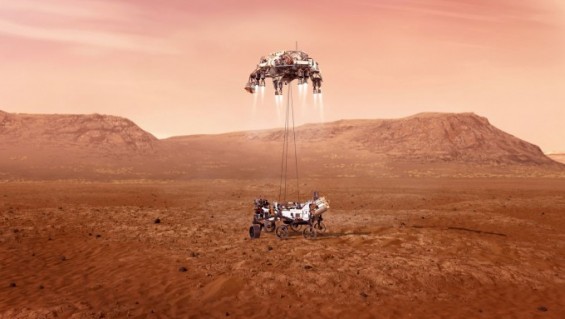
When a signal arrives that Percivirance has landed on Mars safely, staff at the National Aeronautics and Space Administration (NASA) Jet Propulsion Lab (JPL) cheer. Provided by Bill Ingalls/NASA
The U.S. Mars probe’Percivirance’ successfully landed on Mars on the 19th at 5:55 am Korean time. With this, the U.S. succeeded in completing the global Mars exploration campaign, which began in July last year, following the United Arab Emirates (UAE) and China, and achieved a kind of beauty. In particular, the US was the only one among them to penetrate Mars’ atmosphere and made a record of landing on the surface of Mars, which is called ‘7 minutes of horror’.
The National Aeronautics and Space Administration (NASA) broadcasted the landing process of Percivirence live. After confirming the touchdown on the surface of Mars, NASA announced through its homepage that it had landed safely on the’example crater’ located at 18.4 degrees north latitude and 77.5 degrees east latitude on Mars. With the landing of Percivirence, the United States has become a country that has landed a total of five rovers (exploration robots) on Mars so far.
“This landing is an important moment for space exploration in the United States and around the world,” said Acting NASA Commissioner Steve Jurchik. Said.
On July 30, last year, Percivirence was launched by an Atlas-5 rocket from Cape Canaveral Air Force Base in Florida, USA, and reached Mars by flying about 466 million kilometers in 204 days. Percivirence entered the Mars atmosphere at a speed of 5.5 km/s at 5:48 am on the day, and gradually slowed down and attempted to land on Mars.
Since it takes about 11 minutes and 20 seconds for the signal to travel from Mars to Earth, Persivirance moves on its own according to a plan organized in minutes, from entering the Martian atmosphere to descent and landing.
4 minutes after entering the atmosphere, a parachute with a diameter of 21.5 m was deployed to reduce the speed, and after 5 minutes and 10 seconds, the sky crane carrying the rover was separated from the carrying capsule. Skycrane gently settled the rover on the surface at a speed of 0.74m per second at a point 21m above the surface of Mars.
Persivirance is an exploration robot that weighs about 1026 kg. It also includes 23 cameras that can capture clear images and’Ingenuity’, a drone that weighs about 1.8kg that moves by solar power. Ingenuity was created to conduct flight experiments on Mars, where the atmosphere was thin.
As planned, Percivirence performs sampling, water trace search, and organic matter analysis to find traces of life in 687 days, equivalent to one year on Mars. It was also the first in human history to take a sample of Mars and bring it to Earth.
“Percivirance is the first step in bringing Martian rock and dirt to Earth,” said Thomas Jubuchen, NASA’s Scientific Mission Director. “We don’t know what clean samples from Mars will tell us, It will certainly be monumental, including the fact that it may have existed.”
NASA broadcasted the landing process live through the website from 4:15 am on the same day. Major foreign media, such as The New York Times and CNN, also reported the landing process of Percibia in real time.
Retired NASA astronaut Ron Garran told CNN, “If you find any traces of life on Mars, it’s a surprise in itself.” Said.
Meanwhile, China’s Mars probe’Tianwon 1′, which entered Mars orbit on the 10th of this month, is also scheduled to orbit Mars from May to June after stabilization work, and then lower the rover to the surface of Mars. Rover’s intended landing site is the Utopia Plain.

A photograph of Mars sent to Earth right after Percivirence landed on the surface of Mars in the morning of the 19th Korean time. Provided by NASA/JPL-Caltech
